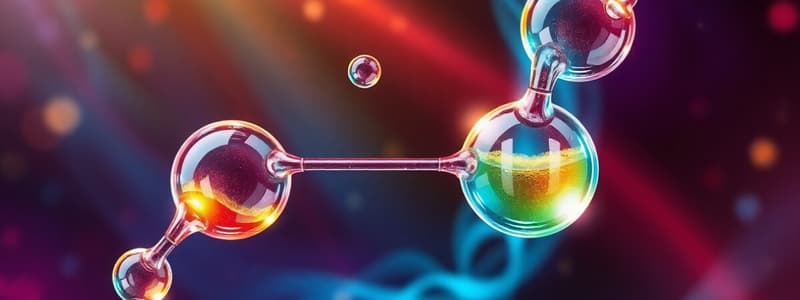Podcast
Questions and Answers
What is primarily used for the formation of acetate esters from acetic anhydride?
What is primarily used for the formation of acetate esters from acetic anhydride?
- Alcohols (correct)
- Water
- Alkoxides
- Amines
Which statement regarding the reactivity of anhydrides is correct?
Which statement regarding the reactivity of anhydrides is correct?
- Anhydrides react faster than alcohols.
- Anhydrides are more reactive than acid chlorides.
- Anhydrides react more slowly than acid chlorides. (correct)
- Anhydrides do not react with amines.
What role do thioesters play in biological chemistry?
What role do thioesters play in biological chemistry?
- They act as strong acids.
- They are involved in nucleophilic substitution. (correct)
- They have no significant function.
- They prevent enzyme activation.
Which catalyst is used for the process of transesterification?
Which catalyst is used for the process of transesterification?
What is the primary product when acetylcholine is hydrolyzed by acetylcholinesterase?
What is the primary product when acetylcholine is hydrolyzed by acetylcholinesterase?
In acid-catalyzed ester hydrolysis, what happens to the base during the reaction?
In acid-catalyzed ester hydrolysis, what happens to the base during the reaction?
What is the expected turnover rate of acetylcholinesterase at a single active site?
What is the expected turnover rate of acetylcholinesterase at a single active site?
What is common about biological ester hydrolysis?
What is common about biological ester hydrolysis?
What type of chemical compound is characterized by a highly reactive 4-membered amide ring?
What type of chemical compound is characterized by a highly reactive 4-membered amide ring?
Which of the following antibiotics is produced by the fungus Penicillium?
Which of the following antibiotics is produced by the fungus Penicillium?
What is the main mechanism by which β-lactams exert their antibacterial effect?
What is the main mechanism by which β-lactams exert their antibacterial effect?
Which characteristic helps differentiate the various penicillins in clinical use?
Which characteristic helps differentiate the various penicillins in clinical use?
Which of these compounds is a semi-synthetic penicillin?
Which of these compounds is a semi-synthetic penicillin?
How do semi-synthetic cephalosporins differ from their natural counterparts?
How do semi-synthetic cephalosporins differ from their natural counterparts?
What is the result of basic hydrolysis of amides?
What is the result of basic hydrolysis of amides?
Which reducing agent is used to convert amides into amines?
Which reducing agent is used to convert amides into amines?
What do ammonia and primary or secondary amines produce when they react with esters?
What do ammonia and primary or secondary amines produce when they react with esters?
What is the product of the reduction of esters when using LiAlH4?
What is the product of the reduction of esters when using LiAlH4?
Why are amides considered to be more stable in vivo compared to esters?
Why are amides considered to be more stable in vivo compared to esters?
How does resonance affect the C—N bond in amides?
How does resonance affect the C—N bond in amides?
What is the typical bond distance of the C–N bond in amides?
What is the typical bond distance of the C–N bond in amides?
What is a characteristic feature of amides regarding their reaction with nucleophiles?
What is a characteristic feature of amides regarding their reaction with nucleophiles?
What is the activation energy for rotation about the C—N bond in amides?
What is the activation energy for rotation about the C—N bond in amides?
What happens to aldehydes upon reduction?
What happens to aldehydes upon reduction?
Flashcards
Basic Hydrolysis of Amides
Basic Hydrolysis of Amides
The process of breaking down an amide by reacting it with hydroxide ions, resulting in the formation of an amide ion.
β-Lactams
β-Lactams
A 4-membered ring containing an amide group. These rings are known for their high reactivity and are found in various antibiotics.
Penicillins
Penicillins
Antibiotics derived from the Penicillium fungus. They are known for their ability to inhibit bacterial cell wall synthesis.
Cephalosporins
Cephalosporins
Signup and view all the flashcards
Semi-Synthetic Penicillins
Semi-Synthetic Penicillins
Signup and view all the flashcards
Penicillin G
Penicillin G
Signup and view all the flashcards
Mechanism of Action of β-lactams
Mechanism of Action of β-lactams
Signup and view all the flashcards
Reduction of Amides
Reduction of Amides
Signup and view all the flashcards
Aminolysis of Esters
Aminolysis of Esters
Signup and view all the flashcards
Reduction of Esters
Reduction of Esters
Signup and view all the flashcards
What are Amides?
What are Amides?
Signup and view all the flashcards
Why are Amides Less Reactive?
Why are Amides Less Reactive?
Signup and view all the flashcards
What are Peptide Bonds?
What are Peptide Bonds?
Signup and view all the flashcards
Resonance in Amides
Resonance in Amides
Signup and view all the flashcards
Acidic Hydrolysis of Amides
Acidic Hydrolysis of Amides
Signup and view all the flashcards
C-N Bond Length in Amides
C-N Bond Length in Amides
Signup and view all the flashcards
Reactivity of acid anhydrides
Reactivity of acid anhydrides
Signup and view all the flashcards
Specific Reactions of Acetic Anhydride
Specific Reactions of Acetic Anhydride
Signup and view all the flashcards
Thioesters: Why are they special?
Thioesters: Why are they special?
Signup and view all the flashcards
Acid-catalyzed esterification
Acid-catalyzed esterification
Signup and view all the flashcards
Base-induced ester hydrolysis
Base-induced ester hydrolysis
Signup and view all the flashcards
What is transesterification?
What is transesterification?
Signup and view all the flashcards
Acetylcholine and its role in nerve impulse transmission
Acetylcholine and its role in nerve impulse transmission
Signup and view all the flashcards
What does acetylcholinesterase do?
What does acetylcholinesterase do?
Signup and view all the flashcards
Study Notes
Carbonyl Compounds 3 - Anhydrides
- Anhydrides react with water, hydroxides, alcohols, alkoxides, and primary/secondary amines to form esters.
- Anhydrides are less reactive than acid chlorides, reacting more slowly.
- Acetic anhydride reacts with alcohols and N-substituted acetamides/amines from amines to produce acetate esters.
Carbonyl Compounds 3 - Anhydrides in Nature
- Anhydrides are present in adenosine triphosphate (ATP), a crucial energy carrier in biological processes.
- The regeneration of a phosphate bond from ester to anhydride results in the release of a leaving group.
- Nucleophilic attack on the phosphorus atom of ATP leads to the formation of a phosphorylated intermediate.
Carbonyl Compounds 3 - Acid-catalysed esterification
- Carbonyl group protonation via lone pair electrons is a key initial step.
- Nucleophilic attack on the protonated carbonyl by an alcohol molecule forms a tetrahedral intermediate.
- Transfer of a proton converts the OR group into a good leaving group.
- Alcohol expulsion regenerates the catalyst.
Carbonyl Compounds 3 - Thioesters
- Nucleophilic carboxylic acid substitution in nature often involves a thioester.
- Thioesters possess unique binding properties that can be readily activated by enzymes.
- Coenzyme A (CoA) is a key example of a biologically crucial thioester.
- Thioesters are involved in metabolic reactions, particularly those related to energy transfer and biosynthesis.
Carbonyl Compounds 3 - Acid Catalysed Ester Hydrolysis
- Protonation of the carbonyl group activates the carbonyl group.
- Nucleophilic attack by water on the carbonyl carbon yields a tetrahedral intermediate.
- Transfer of a proton converts the OR group into a good leaving group.
- The alcohol is expelled, creating a carboxylic acid. Regeneration of the acid catalyst completes the reaction cycle.
Carbonyl Compounds 3 - Base Induced Ester Hydrolysis
- Nucleophilic addition of the hydroxide ion to the ester carbonyl group forms a tetrahedral alkoxide intermediate.
- Elimination of the alkoxide ion generates the carboxylate ion.
- The alkoxide ion abstracts a proton from the carboxylic acid, yielding a carboxylate ion.
- Protonation of the carboxylate ion and the addition of aqueous mineral acid in a separate step yields the free carboxylic acid.
Carbonyl Compounds 3 - Esters - Reactions (Transesterification)
- One alkoxy group in an ester can be replaced by another using either an acid or base catalyst.
- A large excess of the preferred alcohol facilitates the reaction.
Carbonyl Compounds 3 - Acetylcholinesterase
- Acetylcholinesterase is responsible for degrading acetylcholine, a neurotransmitter vital for nerve impulse transmission.
- It hydrolyzes acetylcholine into acetate and choline.
- Acetylcholinesterase is a serine esterase—a vital target for drug interactions, particularly cholinesterase inhibitors.
Carbonyl Compounds 3 - Esters - Reactions (Aminolysis)
- Ammonia and primary/secondary amines react with esters to form amides.
- This reaction progresses via a primary amide intermediate.
- The reaction equilibrium is influenced by the pKa values of the reactants and products.
Carbonyl Compounds 3 - Esters - Reactions (Reduction)
- LiAlH₄ reduces esters to alcohols, but first an aldehyde intermediate is formed.
- Hydride adds to the carbonyl group, eliminating the alkoxide ion, which forms an aldehyde.
- Aldehydes are more reactive than esters.
- Reduction of the aldehyde to a primary alcohol completes the process.
Carbonyl Compounds 3 - Amides
- Amides are unreactive towards water, alcohols, carboxylate ions, and halide ions.
- Incoming nucleophiles are weaker bases than leaving groups.
- Amides are metabolically more stable than esters.
- Amides are less reactive due to resonance stabilization of the lone pair on nitrogen.
- Proteins are composed of amino acids linked together by amide bonds.
Carbonyl Compounds 3 - Amides - Reactions (Reduction)
- LiAlH₄ converts amides to amines, a process distinct from its reaction with esters.
- Converted C=O bond to a CH2 bond.
- Cyclic amid intermediates or lactams form cyclic amines on reduction.
- Loss of carbonyl oxygen via an aluminate anion results in an iminium ion for reduction to amines.
Carbonyl Compounds 3 - Amides - Reactions (Acidic/Basic Hydrolysis)
- Acidic hydrolysis of amides uses H₃O⁺ as a catalyst to yield a carboxylic acid and an ammonium ion.
- Basic hydrolysis of amides uses hydroxide ions to yield a carboxylate anion and an ammonia molecule.
Carbonyl Compounds 3 - β-lactams
- β-lactams are highly reactive, four-membered amide rings.
- They are crucial components of various antibiotics.
- Penicillins and cephalosporins are examples of drugs containing β-lactam rings.
- Semi-synthetic modifications of penicillin and cephalosporins exist.
Carbonyl Compounds 3 - Further Reading/References
- Student resources like Bruce's Organic Chemistry, chapters on carbonyl compounds are recommended for expanding knowledge on this topic.
- Relevant chapters in other standard organic chemistry textbooks by authors such as Clayden, Crowe, McMurray, Solomons, Wade, and Fox, etc., are helpful reading.
Studying That Suits You
Use AI to generate personalized quizzes and flashcards to suit your learning preferences.



